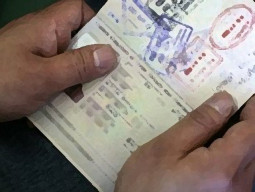
Just when we got used to the sight of drones in the sky, capturing stunning aerial views, it’s time to get a grasp on a new idea: drones underwater.
Like its airborne cousin, an underwater drone is released to fulfill a mission on its own. It follows a pre-programmed path, captures images and other data, and delivers them back to base.
Pakistani cameraman wins Rory Peck Award in London
 A ctenophore with long tentacles found at the bottom of the Pacific Ocean. PHOTO COURTESY: NOAA OCEAN EXPLORER
A ctenophore with long tentacles found at the bottom of the Pacific Ocean. PHOTO COURTESY: NOAA OCEAN EXPLORERIntelligent aquatic drones could even make autonomous decisions, like changing course to avoid obstacles, or identifying areas of particular interest. At least that’s the idea.
Himalayan lakes
Underwater drones are a very new concept, and a team of four young scientists in Australia is at the forefront of pushing its boundaries. They formed a startup called Abyss, operating out of Sydney.
Before getting into the details of Abyss’s product, it’s worth taking a moment to appreciate the team’s qualification. It’s a fairytale story of Australian immigration.
At the helm of Abyss is CEO Nasir Ahsan, a Pakistani who holds a PhD in marine robotics.Co-founders include his wife Hina Ahsan, who holds a master’s degree in data analytics; Masood Naqshbandi, a sensor technology expert from Afghanistan; and Abraham Kazzaz, a civil engineer and Australian of Lebanese descent.
When a US vice president invited a Pakistani camel cart driver to America
They’ve known each other for a while, crossing paths in academia and as friends. Abraham is the only “true Australian,” Nasir jokes — but all four are Australian citizens now.
 The Hercules ROV in action. PHOTO COURTESY: NOAA PHOTO LIBRARY
The Hercules ROV in action. PHOTO COURTESY: NOAA PHOTO LIBRARYNasir grew up near the high-altitude Himalayan lakes in Pakistan. This, he says, instilled in him a longing for underwater exploration. “Nobody has ever mapped them, exposed the depths of these,” he says.
It took a while for everything to align so that Nasir could turn his youthful fascination into a career. Starting out with computer science, he became involved with artificial intelligence, applied this to autonomous systems, then stumbled upon the emerging field of underwater robots. Here, all of his interests came together, and he’s now one of a handful of specialists worldwide.
In his life as a researcher, he’s handled everything from small autonomous vehicles to multimillion-dollar remotely operated underwater vehicles (ROVs). He’s even been on board ocean exploration vessel MS Nautilus on a mission to explore hydrothermal vents in the deep sea.
When the next possible British PM rode a rickshaw in Karachi
“On the Nautilus, I was the navigator for the Hercules ROV, which is equipped with powerful high-definition cameras. We saw a lot of wonderful things there,” he says.
The limits of academia
In the long run, Nasir found academia too limiting. The idea arose to assemble a dream team of close friends to start a business. “Academia is a great place to be, however it does not give me the freedom of research. It’s always driven by who funds me. I wanted to fund my own research,” Nasir explains.
Nasir had already defined which particular aspects of underwater robotics he wanted to tackle. On top of that list was making the field more accessible to more people. “There’s a lot of stuff restricted to big companies, like oil companies, or the scientific community,” he says.
Abyss’ primary goal is to make underwater robots attainable for smaller companies or even individuals. This can be achieved by incrementally improving on existing underwater robots.
At one end of the scale are the heavy-duty, multi-million dollar ROVs like the Hercules. On the other end, new, nimbler versions are emerging. The significant breakthrough was made by a Bay-area initiative called OpenROV.
Miss Pakistan USA on a mission to change image of Pakistani women
This open source underwater robot development kit is spearheaded by former NASA engineer Eric Stackpole. Abyss’ prototype is based on the OpenROV. To Nasir’s knowledge, Abyss is the first startup in the APAC region to seriously get into iterating on the model.
The working prototype
Nasir found that a good business opportunity for aquatic drones lies in routine inspection of underwater infrastructure like dams, waterways, reservoirs, pipelines, or even fish farms.
Abyss has a working prototype that can collect image data, stitch this together to form a 3D model, and is developing algorithms to help detect faults. It’s still work in progress, but Abyss already has paying clients. One of them is Sydney Water, a major Australian utility company.
 Sydney’s Alexandra canal is flanked by factories and warehouses. PHOTO COURTESY: bondivillage.com
Sydney’s Alexandra canal is flanked by factories and warehouses. PHOTO COURTESY: bondivillage.comFor Sydney Water, Abyss runs a trial project for inspections of the Alexandra Canal. “They couldn’t find anyone else to do it,” Nasir explains. “It’s an industrial zone with a lot of waste, they don’t want people in boats around there. Aerial drones are also not allowed because it’s near the airport.”
From Germany to Layyah: Pakistani completes 10,000km journey on bicycle
Abyss plans to improve on the capabilities of its drone incrementally, along with the requirements of its growing client portfolio. “For example, if we get into sewage, we’ll take on sonar,” Nasir explains.
The future of robots at sea
Nasir defines five areas in which existing model needs improvement: vision, positioning, cost, communication, and power supply.
“If we can take on a couple of these issues one step at the time, and if we can solve some of them, we can bring the underwater world a bit closer,” Nasir says.
New sensors would drastically improve the drone’s capability, sensors that can analyze the environment from a chemical perspective, Nasir says. “That could be the next big area to crack the underwater world.”
 A red medusa, one of the many wonders made visible by deep sea exploration. PHOTO COURTESY: NOAA OCEAN EXPLORER
A red medusa, one of the many wonders made visible by deep sea exploration. PHOTO COURTESY: NOAA OCEAN EXPLORERBut improvements can also be made in the algorithms that direct the drone’s behavior, and in analyzing the collected data effectively to maximize results for the client. One major problem to solve is communication.
Up until now, underwater drones require tethering, a sort of umbilical cord which ties the robot to its handler. One of Abyss’ goals is to eventually cut that cord, making the drone truly autonomous.
Two Pakistanis part of BBC's 100 inspirational women 2015
To keep improving its prototype and transition from a services-based model into a scalable one, the startup chose to participate in the Muru-D startup accelerator program in Sydney.
“Without help from outside, we can’t get the business running,” admits Nasir.
In six months, by the time Abyss has completed the Muru-D program, it hopes to have built the foundations for a licensing-based business model. The idea is that companies pay to use Abyss drones for a set period of time. The drone needs to be at a stage where it can operate by itself, requiring no on-site handling by an expert. The Abyss team would stand by only for maintenance and problem-solving.
Right now, Abyss is using client money and government grants to support itself, but once it’s come out of Muru-D and the business model works, Nasir says, it’s ready to take on seed funding.
Hamza Amin becomes first Pakistani to play Australian Open golf tournament
As an explorer and visionary, Nasir’s long term goals extend well beyond inspecting industrial infrastructure and sewage canals.
“We’re just at the start of the underwater revolution. Even consumer applications are thinkable. What about storing stuff underwater, or delivery under water. There is so much space there,” he says.
This article originally appeared on Tech in Asia.












































COMMENTS (1)
Comments are moderated and generally will be posted if they are on-topic and not abusive.
For more information, please see our Comments FAQ